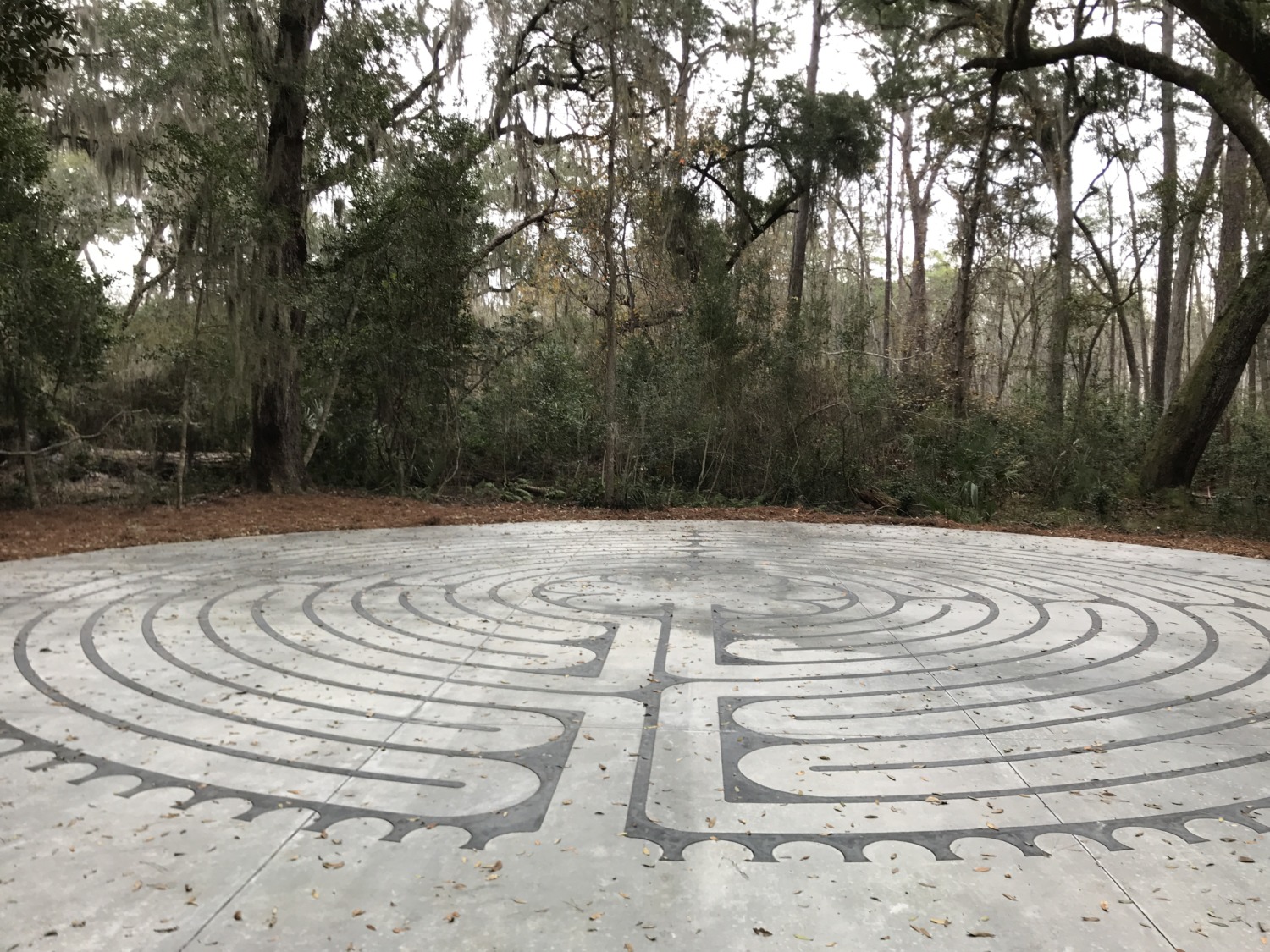Christ Church, the Episcopal church next to the RV sites at Fort Frederica, built a Prayer Labyrinth. I have been taking advantage of this way of praying when I take my morning walks on our days off.

I have not been attending worship on Sunday mornings since we came to Georgia. Tom and I work on Sundays and I used to go to Wesley United Methodist Church’s 8 a.m. worship service before I went to work. Wesley is no longer a United Methodist Church. They withdrew from the UMC and decided to become independent instead of joining another denomination. I had been going there before work since 2017 and they were used to me wearing my historical clothing. But I am not going to support their decision to leave the denomination.
I could go to Christ Church, Episcopalian. Tom and I have been Lutheran and Presbyterian since we retired and Episcopalian isn’t really any different. They are within walking distance and have an 8 a.m. service. But it seems like a lot of work to attend someplace new when we are only going to be here another month. On Ash Wednesday we attended service at the St. Simons United Methodist Church. They did not withdraw from the denomination. We have been trying to find places that have Lenten services in the evening. You would think that would be easy in the Bible Belt, but we have not been very successful.
Because I have not been attending worship on Sunday mornings, I have been using the Prayer Labyrinth as an opportunity for guided mediation and prayer several mornings a week. Before I started doing this, I had never used a prayer labyrinth. I’ve seen them and read about them. They seemed like a good idea. I just never did it.
Walking a prayer labyrinth is an ancient practice in Christianity. The oldest Christian labyrinth is from an Algerian church and dates back to 350 C.E. Labyrinths started to be used more widely as an alternative to pilgrimages to the Holy Land after Jerusalem was conquered by Muslims in 638 C.E. People would walk the labyrinth to symbolize making a pilgrimage.
One of the most famous prayer labyrinths is located on the floor of Chartres Cathedral in France, built in 1201 C.E. The Christ Church labyrinth is the same design as the Chartres labyrinth. The labyrinth is not a maze. There is one entry point, a single path to follow to the center, and the exit is following that path in reverse. As you walk in you are walking towards God, the center of the labyrinth. Your arrival at the center symbolizes union with God. As as you exit from the center, you are going with God back out into the world.
The challenge of the labyrinth is to open oneself progressively to Christ before advancing towards the altar, the love that Christ gave and a desire to surpass all personal difficulties. The opportunity is given to re-evaluate your sins – abandon them and seek forgiveness in order to advance. The purpose is to meditate with Christ on death and eternal life. Because of this, walking the prayer labyrinth is especially appropriate during the Lenten season.
Walking the labyrinth is a slow, quiet, meditative process that attends to the desire to make a journey toward God. It is a way to embody prayer, to keep it from being theoretical or mental, to let our whole selves be attentive to God. It is a way to set aside time to pray and to be with God; to put down our phones, to have conversation with God, to be alone or to be with others in prayer.
There are many ways to use a prayer labyrinth. As I explore this method of praying, I have been experimenting with four suggestions found in this Guideposts article. I choose one method per day and focus on that way of praying for the day.
1) Ask God a question as you enter the path. Then, as you walk slowly through the twists and turns, listen for an answer. Let your steps and your silence invite the presence and guidance of God.
2) Start your journey to the center with confession (you may want to visualize your sins being left behind with every step you take). When you reach the center, journey out with affirmation (perhaps visualizing yourself picking things up or putting things on–like the righteousness of Christ, the smile of the Father, the purity of the Holy Spirit, etc.). Pause at the exit and give thanks for your cleansing journey.
3) Recite a breath prayer as you navigate the labyrinth, perhaps praying a different prayer on each leg or quadrant of your journey.
4) Lay down your burdens as you walk to the center of the labyrinth (perhaps laying down pebbles along the way as symbols of your worries or cares). In the center, pause to thank God for taking your burdens on himself Then count your blessings and give thanks on the journey to the exit.
As I have been walking the prayer labyrinth, I have noticed how my faith and life mirror each other. Both are journeys that sometimes have taken me in surprising directions. Sometimes my path seems clear and I feel like I am walking confidently with God. Other times there are twists and turns that don’t allow me to see my direction ahead. I always find God at the center, even when it feels that I have been wandering aimlessly. Knowing that I am centered on God in my heart allows me to move out in faith.
Have you ever tried walking a prayer labyrinth? If you would like to find a labyrinth near you, you can use this labyrinth locator. You might be surprised at the number of them that are close by.
